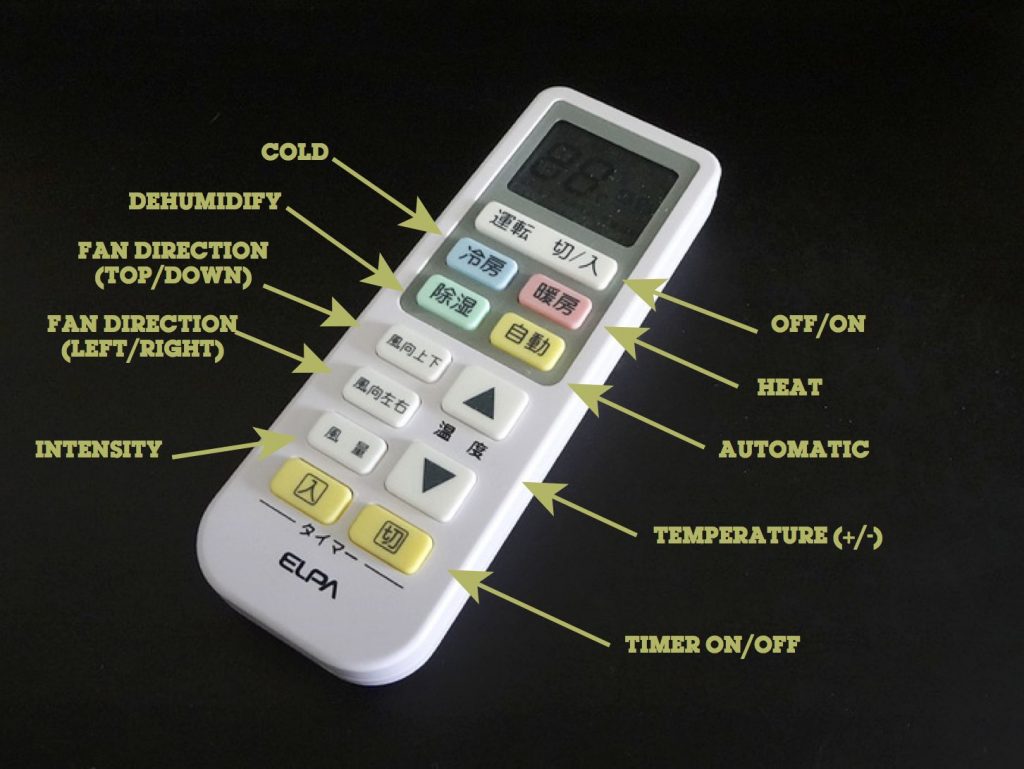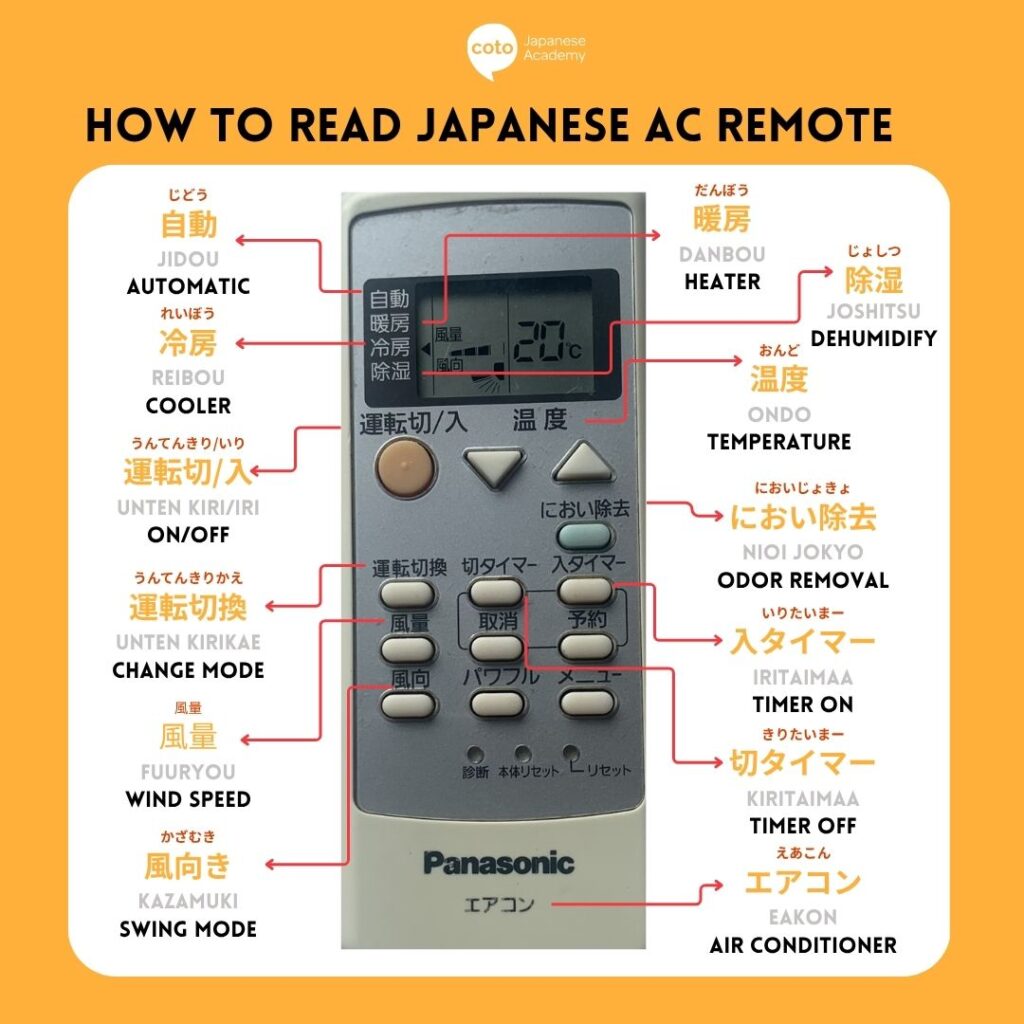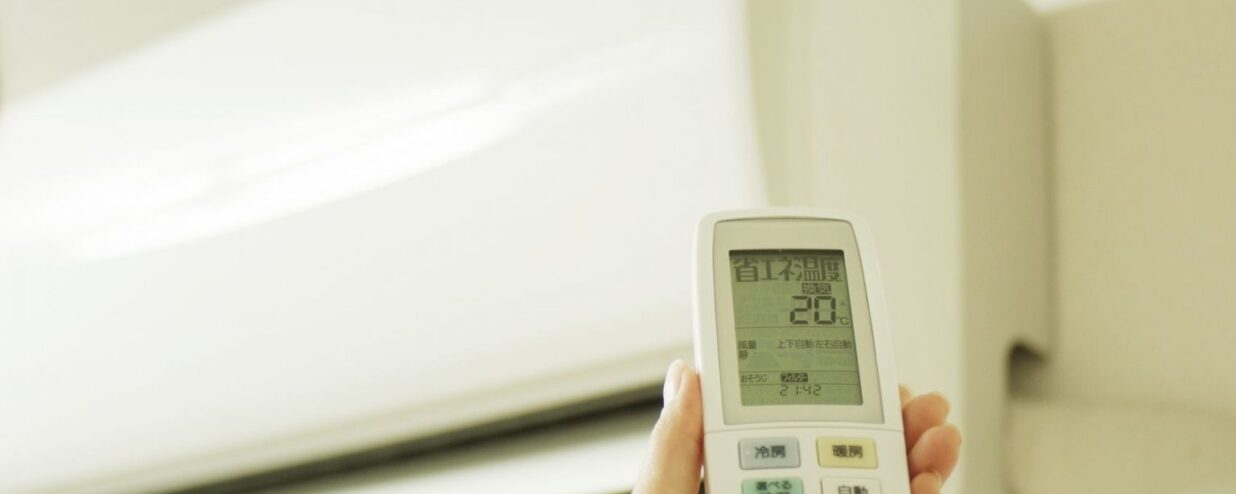Japanese summers can be intense, with scorching heat combined with heavy humidity that often leaves you reaching for the air conditioner, or エアコン (eakon) to cool down. But how do you use a Japanese air conditioner and use the remote control, called rimokon (リモコン)?
You might be met with a wall of kanji that makes adjusting the settings feel like solving a puzzle. How do you lower the temperature? Boost the fan? Or switch to energy-saving mode?
In this guide, we’ll walk you through the essential functions and terms found on a typical Japanese air conditioner remote. And who knows, you might even find yourself more motivated to study Japanese once you realize just how useful it can be in everyday life!
Basic Functions of the Japanese Air Conditioner Remote

If you live in a Japanese apartment that has already installed an air conditioner, chances are that the remote control is mounted to the wall, often right below the air conditioner. Keep in mind that most AC in Japan are mini-splits, not central AC.
To turn on and off the air conditioner, take note of some of the most basic functions. Depending on the remote control, you will see different labels for the on/off function.
| Japanese Term | Romaji | English Translation |
|---|---|---|
| 運転 or 入 | Unten or iri | On |
| 停止 or 切 | Teishi or kiri | Off |
| 取り消し | Torikeshi | Cancel |
Advanced Japanese AC Remote Control Functions

Of course, using the AC remote control involves more than just turning it on and off. For example, you might want to change the wind or swing modes.
The “change” button will allow you to navigate through the different functions of your air conditioner. If you have an automatic mode, your AC will regulate the temperature and humidity in your room by itself, so you don’t need to set up anything else.
You can set up the temperature (温度), the fan direction (風向 or スイング), and its intensity (風量) with the up and down arrows. If your model offers you a timer function, you can program your air conditioning to automatically turn on or off.
| Function | Japanese Term | Romaji | Description |
|---|---|---|---|
| Temperature | 温度 | Ondou | Adjusts how warm or cool the air is. |
| Fan Direction | 風向 or スイング | Kazamuki or swingu | Controls the direction of airflow or activates swing mode. |
| Fan Intensity | 風量 | Fuuryou | Sets how strong the fan blows. |
| Timer (if available) | タイマー機能 | Taimaa kinou | Sets the air conditioner to turn on or off at a specific time. |
How to Change AC Temperature with Your Remote
Changing the temperature with your remote control is usually the simplest adjustment. Look for the button labeled 温度(おんど / ondo), which is typically paired with up (▲) and down (▼) arrows.
Be careful! If your room still feels warm even after setting a low temperature, you might accidentally be in heating mode(暖房 / だんぼう). Always double-check the mode setting(運転切り替え) to make sure you’re using the correct one!
How to Change Air Conditioner Modes
The 運転切り替え(unten kirikae) button, often labeled “Mode” on a remote control, allows you to switch between different operation modes on a Japanese air conditioner. Pressing it will cycle through several functions. This is because Japanese people use the AC year-round for both summer and winter.
| English | Japanese Term | Romaji | Function |
|---|---|---|---|
| Cooling | 冷房 | Reibou | Cools the room |
| Heating | 暖房 | Danbou | Warms the room |
| Dehumidifying | 除湿 | Joshitsu | Removes moisture from the air |
| Fan Only (Ventilation) | 送風 | Soufu | Circulates air without heating or cooling |
| Automatic | 自動運転 | Jidou unten | Automatically adjusts mode based on room temperature |
How to Change AC Wind Strengths
Most AC remote controls allow you to adjust the air strength, or fan intensity. Look for the button labeled 風量 (fuuryou). Pressing it will cycle through different fan strength levels, such as low, medium, high, or automatic, depending on how advanced your model is.
In some cases, the fan strength is displayed as a bar graph on the remote screen!
| English | Japanese Term | Romaji | Notes |
|---|---|---|---|
| Ventilate | 送風 / 換気 | Soufuu/kanki | 送風 = fan-only mode; 換気 = ventilation (fresh air) |
| Strong (wind) | 強風 | Kyoufuu | High fan intensity |
| Weak (wind) | 弱風 | Jakufuu | Low fan intensity |
| Quiet | 静か | Shizuka | Quiet mode (reduces noise) |
| Automatic | 自動 | Jidou | Auto mode |
Changing AC Wind Direction in Japan
風向 (kazamuki) refers to the direction of the airflow from your air conditioner. This setting lets you control where the air is blowing—upward, downward, or to the sides, so you can adjust it for comfort or efficiency.
Most A/C remotes have a 風向 button, or sometimes a スイング (swing) button.
Tip: Using the right airflow direction can improve comfort and energy efficiency! Cool air falls, so point the vents upward when cooling during the summer, and downward when heating during the winter
Setting Up Timer with Japanese AC Remote
If you want to save energy, Japanese air conditioners come with a タイマー (taimaa) function that lets you schedule the unit to turn on or off automatically at specific times.
- Off timer (切タイマー / きりたいまー): The time you want the aircon to stop automatically.
- On timer (入タイマー / いりたいまー): The time you want the aircon to start automatically.
How to set up the timer:
- Look for the button labeled タイマー.
- Typically, you set the timer by pressing the タイマー (taimaa) button repeatedly. Each press usually increases the time in one-hour increments (e.g., once for 1 hour, twice for 2 hours, and so on).
- Sometimes, you will have to press 予約 (yoyaku) to confirm the AC timer.
Other Japanese AC Remote Control Functions
In addition to the standard functions, some modern air conditioning units offer extra modes such as clothes-drying, self-cleaning, and even an energy-saving mode.
| Function (English) | Japanese Term | Drying function if you are drying your clothes indoors | Description |
|---|---|---|---|
| Dehumidify | ドライ / 除湿 | dorai / joshitsu | Removes moisture from the air |
| Clean Room Air | 空気清浄 | kuuki seijou | Purifies indoor air (if equipped) |
| Energy Saving Mode | 省エネ | shou ene | Saves power by optimizing operation |
| Self-cleaning setting | 内部クリーン | naibu kuriin | Sets the AC to clean i tself |
| Laundry-drying mode | 衣類乾燥 | Irui kansou | Sets the AC to clean itself |
While many Japanese A/C remote controls include other features, the buttons we’ve covered are the most basic and commonly used. In hotels, you may find the remote control (or rimokon) built into the wall. The layout might be different, but the labels are usually the same, so you’ll still be able to recognize the key functions!
If you are travelling to Japan soon, don’t forget to check our guide on the best things to do in Tokyo during summer. And of course, knowing how to use a Japanese A/C is just the beginning! Make sure to explore our list of summer-related Japanese vocabulary to help you stay cool and our guide to navigating the Japanese rainy season.
Build Japanese Skills You’ll Use for Life with Coto Academy!
What’s next? If you want to live in Japan, learning Japanese skills that you actually use in daily life is essential. Fortunately, Coto Academy offers flexible classes tailored to practical, everyday Japanese. Our native teachers base lessons on real-life situations, not just textbook material.
Start building your real-world Japanese skills with Coto Academy today!
Want to study Japanese with us?
FAQ
What is air conditioner in Japanese?
Air conditioner in Japanese is called eakon (エアコン).
What is AC remote control in Japanese?
AC remote control in Japanese is called rimokon (リモコン), short for remote control.
Japanese AC remotes often include buttons labeled in Japanese such as 温度 (temperature), 風量 (fan strength), 風向 (wind direction), and タイマー (timer). Understanding these basic controls helps you use the air conditioner efficiently.
How do I set the temperature on a Japanese AC remote?
Look for the 温度 (ondo) button, usually with up and down arrows. Press these to increase or decrease the room temperature.
